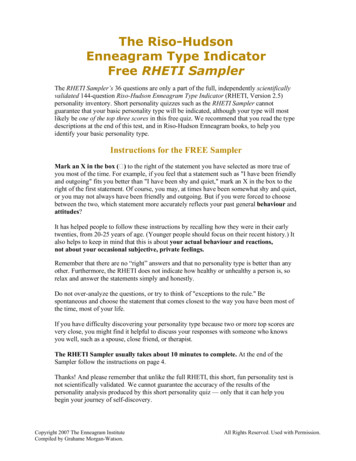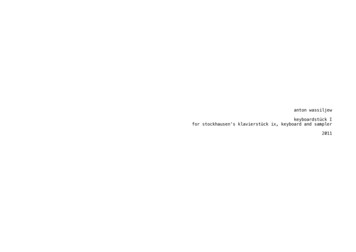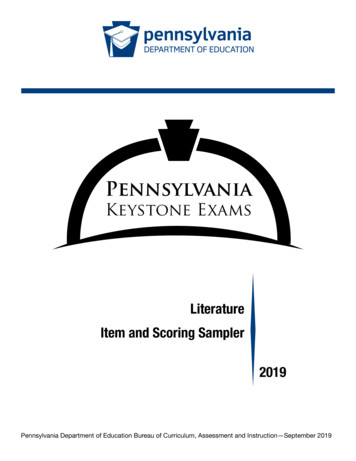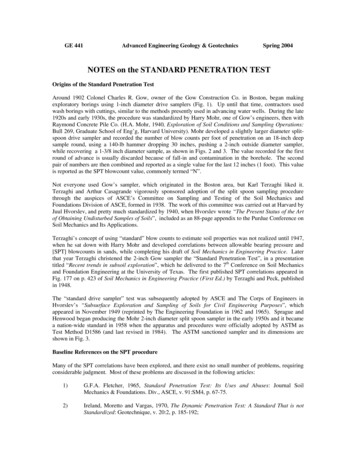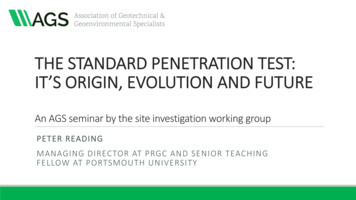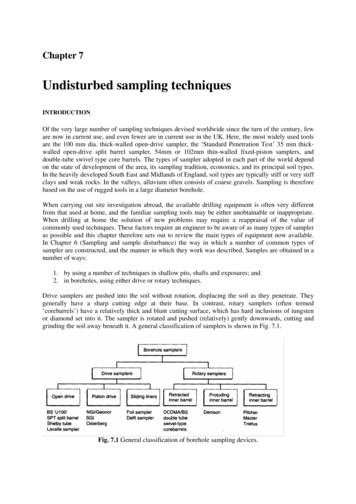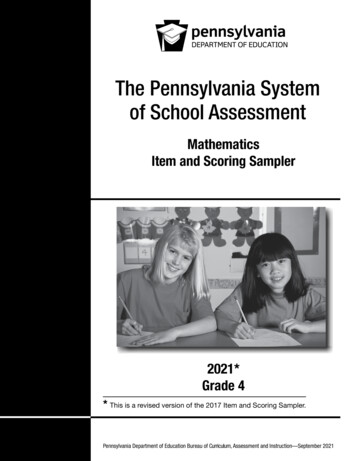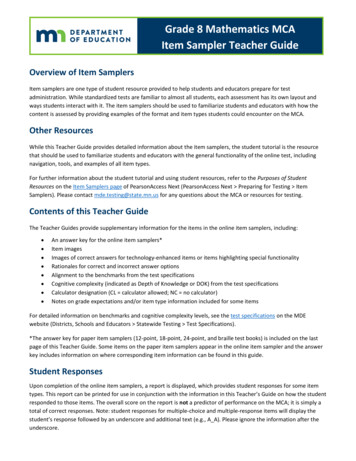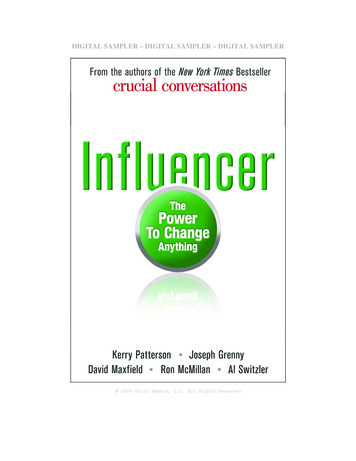
Transcription
DIGITAL SAMPLER – DIGITAL SAMPLER – DIGITAL SAMPLER 2008 Vital Smarts, L.C. All Rights Reserved
INTRODUCTION
007148499X Grenny[7].qxd7/24/078:41 PMPage 131You’re an InfluencerI wanted the influence. In the end I wasn’t very goodat being a [university] president. I looked out of the windowand thought that the man cutting the lawn actuallyseemed to have more control over what he was doing.—Warren BennisTo get a glimpse of what it takes to exert profound influence, to literally change anything, we first travel to SanFrancisco and look in on influence master Dr. MimiSilbert. Consider what Silbert has been able to do by applyingthe best of today’s influence strategies to one of today’s mostnoxious problems. She is the founder of the Delancey StreetFoundation, a one-of-a-kind organization with headquarters atan upscale address on San Francisco’s Embarcadero. Silbert’scompany is part corporate conglomerate and part residentialtherapy. It consists of several dozen businesses, all headed bySilbert.What’s unique about the institution is the employee population. In Silbert’s words, “They’re nasty, racist, violent, andgreedy. They’re thieves, prostitutes, robbers, and murderers.”Then she adds: “When we started 30 years ago, most were gangmembers. Today many are third-generation gang members.”According to Silbert, “These guys get letters from Grandma saying, ‘Get back here—the gang needs you!’ ”13
007148499X Grenny[7].qxd7/24/078:41 PMPage 1414 INFLUENCERDr. Silbert’s typical new hires have had four felony convictions. They’ve been homeless for years, and most are lifetimedrug addicts. Within hours of joining Delancey, they are working in a restaurant, moving company, car repair shop, or oneof the many Delancey companies. And other than Silbert herself, these felons and addicts make up the entire population atDelancey. No therapists. No professional staff. No donations,no grants, no guards—just a remarkable influence strategy thathas profoundly changed the lives of 14,000 employees over thepast 30 years. Of those who join Delancey, over 90 percentnever go back to drugs or crime. Instead they earn degrees,become professionals, and change their lives. Forever.MEET JAMESOne of the employees we met is a well-scrubbed, affable butsteely-eyed fellow we’ll call James. James’s story is typical of Silbert’s staff. Like many of the 500 residents living on the SanFrancisco campus, James was a career criminal and drug addictbefore coming to Delancey. And like most, he started young.After four years as a regular runaway, criminal, and drug abuser,James turned 10. By that time Illinois was fed up with hisshenanigans and had tracked down James’s father—who abandoned him at age one. State justice authorities wished Jamesgood luck as they stood at a gate at the O’Hare airport whilemaking sure he understood that he was no longer welcome inChicago.James flew to Oakland, California, where he took up residence with his father near the docks. The first lesson his dearold dad taught him was how to shoot heroin. The next 25 yearsconsisted of an uninterrupted period of violent crime, drugabuse, and prison time. Six years ago he was convicted of yetanother violent offense and sentenced to 18 years with no hopeof parole for 16 years. That’s when he asked to join Delanceyrather than serve his full sentence.
007148499X Grenny[7].qxd7/24/078:41 PMPage 15You’re an Influencer 15James changed in ways that are hard to imagine. When wefirst visited Delancey, he was professionally dressed and had notused drugs or alcohol in two years. To learn how Dr. Silbertinfluences this kind of change, we touch base with her workthroughout this book. She draws from the principles and practices of every one of the influence geniuses we’ve studied to date.Combining principles learned in Tanzania, practices honedin Mexico City, and theories developed in Palo Alto helps usunderstand how Ralph Heath in Marietta, Georgia, was able toinfluence the behavior of 4,500 engineers and craftsmen to movea stalled product from design to production, resulting in billionsof dollars in needed sales; why Mike Miller was able to changethe culture of a massive IT group in order to dramaticallyimprove performance; and what makes it possible for an individual who has struggled to lose weight for years to finally turn thecorner. But most importantly, these proven concepts, principles,and theories will help you, your family, your company, and yourcommunity develop an influence repertoire of enormous power.SOME AMAZING CASESLeaving San Francisco for warmer climes and more farreaching methods, we head to Mexico City to visit TV producer Miguel Sabido. He has created a method for influencing hundreds of thousands of people at a time.Sabido has perfected strategies for changing how peoplethink and behave by producing life-changing soap operas—ofall things. At one point, when Sabido aimed his popular TVshow Ven Conmigo (“Come with Me”) at improving literacy(a problem that had remained intractable for decades), his TVcharacters propelled over a quarter of a million viewers into thestreets of Mexico City—all in search of free literacy bookletsthat were shown on the program. Sabido’s work in entertainment education has now been replicated in dozens of countries with remarkable success. A careful review of his work helps
007148499X Grenny[7].qxd7/24/078:41 PMPage 1616 INFLUENCERus understand how to use one of the world’s best tools for helping others willingly change their minds.Switching our attention to Ithaca, New York, we see BrianWansink explore how the physical world can either help orhinder people in their quest to shed unwanted pounds. Bylearning how Wansink and others enlist the “curious power ofpropinquity,” we are able to apply the same methods to, say,propel your kids to read more books, or encourage coworkersto collaborate.To learn how to develop one of the most important of allinfluence methods, we travel to Atlanta, Georgia, and meet Dr.Donald Hopkins and his staff at The Carter Center. Their workacross Africa and Asia teaches us how to identify a handful ofvital behaviors that help change the habits of millions of people. In this case, he and his colleagues help change the dangerous water-drinking habits of millions of remote villagers.Hopkins’s work on applying principles of “positive deviance”helps us all understand what it takes to discover a handful ofhigh-leverage behaviors that drive virtually every change effortwe’ll ever undertake.Try this for a challenge. Since 1986, Dr. Hopkins and histeam at The Carter Center in Atlanta have focused on the eradication of the Guinea worm disease. The Guinea worm is oneof the largest human parasites (it can grow to three feet long),and it has caused incalculable pain and suffering in millionsof people. When West Asian and sub-Saharan villagers drinkstagnant and unfiltered water, they take in the larvae of Guineaworms, which then burrow into abdominal tissues and slowlygrow into enormous worms.Eventually the worms begin to excrete an acidlike substance that helps carve a path out of the host human’s body.Once the worm approaches the skin’s surface, the acid causespainful blisters. To ease the horrific pain, victims rush to thelocal water source and plunge their worm-infected limbs intothe pond for cooling relief. This gives the worm what it
007148499X Grenny[7].qxd7/24/078:41 PMPage 17You’re an Influencer 17wanted—access to water in which to lay hundreds of thousandsof eggs, thus continuing the tragic cycle.Sufferers cannot work their crops for many weeks. Whenparents are afflicted, their children may drop out of school tohelp out with chores. Crops cannot be cultivated. The harvestis lost. Starvation ensues. The cycle of illiteracy and povertyconsumes the next generation. Often, secondary infectionscaused by the worm can kill. Consequently, for over 3,500 yearsthe Guinea worm has been a major barrier to economic andsocial progress in dozens of nations.In 1986 Dr. Hopkins and his colleagues declared war onthe worm. Hopkins was interested in this particular diseasebecause he knew that if 120 million people in 23,000 villageswould change just a few vital behaviors for just one year, therewould never be another case of the infection. Ever. But imagine the audacity of intending to influence such a scattered population in so many countries—frequently faced with corrupt ornonexistent health systems or fragile political stability.And yet this is exactly what Hopkins’s team has done. Soonhe and his colleagues will have laid claim to somethingnever before accomplished in human history. They willhave eradicated a global disease without finding a cure. Despitethis enormous disadvantage, Hopkins and his small band ofintrepid change agents will have beaten the disease with nothing more than the ability to influence human thought andaction.The implications of Hopkins’s work for individuals, businesses, and communities are enormous. Everyone has a versionof a Guinea worm disease: some self-defeating behaviors that,if changed, could unlock a whole new level of performance.Hopkins teaches us first how to find success where others havefailed, and second, how to locate a handful of key actions that,if routinely enacted, will guarantee our own success.Who can’t benefit from learning how to locate strategiesthat routinely succeed in the face of widespread failure?
007148499X Grenny[7].qxd7/24/078:41 PMPage 1818 INFLUENCERSTUDY WITH THE BEST SCHOLARSHopkins, Silbert, Sabido—in fact, virtually all the influencerswe studied—draw on the same sources: a handful of brilliantsocial scientists you’ll meet in this book. For now, let’s meet theone almost all cited as the scholar of scholars: Albert Bandura.He’s a genius whom influence masters routinely study. Whenwe first entered the offices of the practitioners we studied, mostdisplayed Dr. Bandura’s works on their bookshelves. His nameleaped out at us because our history with him goes back over30 years.We first encountered Bandura in the mid-1970s in hismodest office at Stanford University. There we met a mildmannered and brilliant man who was already legendary as thefather of social learning theory. When we reconnected withhim three decades later, at an energetic 83, Dr. Bandura wasstill up to his neck in influence research that continues to tiltthe world. He can still lay claim to the fact that he’s the mostcited psychologist alive.Here’s how Bandura’s work fits into the world of influenceand can be of enormous help to all of us. In his early years, Dr.Bandura generated a remarkable body of knowledge that ledto rapid changes in behaviors that other theorists had dawdledover for years. Phobics who’d spent years on a couch were freedin hours. Addicts who had used drugs for decades became cleanin weeks and were well on their way to making the transformative changes in their lives that would keep them clean.Individuals struggling with obesity for a lifetime developed newhabits in months.One of Bandura’s classic studies demonstrated, for example, how powerfully our behavior is shaped by observing others. This came at a time when most psychologists believed thatbehavior was solely influenced by the direct rewards and punishments people experienced. This was the age of strict behaviorism. And yet Bandura’s intense curiosity about how tochange human behavior made him impatient with such sim-
007148499X Grenny[7].qxd7/24/078:41 PMPage 19You’re an Influencer 19plistic explanations. So he took a daring swing at the establisheddogma and began an exodus toward a much more powerfultheory.Seeing a rise in violence corresponding with the diffusionof television, Bandura thought it worthwhile to examinewhether juveniles were learning violent behaviors by watchingTV characters smack, kick, and shoot one another. To explorethe effects of TV violence, Bandura and a team of graduate students watched closely as nursery school children played in asmall room packed with toys—dolls, tiny stoves, balls, and soforth. Among this tempting array of playthings was a “Bobodoll”—a large plastic blow-up doll with a weight in the bottom.If you punch the doll in the nose, it bounces right back so youcan punch it again.Left to their own devices, children played with several ofthe toys, moving from one to the next—occasionally givingBobo a punch or two. But what if researchers demonstratednovel aggressive behavior for the children? Would kids learnthrough simple observation? To answer this question, Bandurashowed a different group of children a short movie of a womanmodeling novel aggressive behavior. She pummeled the Bobodoll with a mallet. She flung the plastic toy into the air, kickedit repeatedly, and eventually sat on it and beat it. That seemednovel enough.The children who watched the film were then released oneat a time into the toy room. Would simple modeling influencetheir behavior? You only have to watch the black-and-whitefilm segments taken of the experiment for a few seconds toanswer the question. A little girl wearing a dress—completewith a 50s-style poofy petticoat—enters the room, digs throughthe toys until she finds the mallet, and starts whaling on Bobo.She and the dozens of other nursery school kids who followedher demonstrate all the aggressive behavior they had seenmodeled—including inventive new forms of aggression suchas beating the doll with a cap gun. In Bandura’s own words,
007148499X Grenny[7].qxd7/24/078:41 PMPage 2020 INFLUENCER“They added creative embellishments. One girl actually transforms a doll into a weapon of assault.” There she is—that cutelittle girl in the frilly outfit—smacking Bobo with Raggedy Ann.In addition to demonstrating that humans are influencedby watching the behavior of others, Bandura was able to provethat the violence pumped out by the television networks waslikely to exact a terrible toll on viewers. Dr. Bandura caps hisreview of his classic study by stating with a twinkle: “Thisresearch didn’t get me onto the Christmas-card list of thebroadcast industry.” But it did put him smack dab in the center of influence research.This work, when combined with hundreds of otherBandura studies that have been aimed at fixing an ailing world,teaches us the very first thing we need to know about influence.Influence strategies can indeed be studied, tested, and mastered. Bandura also taught us where not to waste our time. Forinstance, if you want others to change, you don’t have to putthem on a couch for 10 years to learn about their critical childhood moments. You also need not trouble yourself by laying atrail of Reese’s Pieces in front of others to propel them througha maze. Humans aren’t simple-minded pawns who can be readily manipulated to do whatever you like—even if you have theright amount of candy.In fact, Bandura found humans to be quite complicated. Itturns out that they think. Humans observe, cogitate, draw conclusions, and then act. All this is important to know because ifyou want to change the world, you eventually have to changehow people behave. And if you want to change how theybehave, you have to first change how they think.WHAT THIS MEANS TO YOUThere’s good news in all of this. Since our ineffectiveness atinfluencing others stems from a simple inability rather than acharacter flaw or lack of motivation, the solution lies in con-
007148499X Grenny[7].qxd7/24/078:41 PMPage 21You’re an Influencer 21tinued learning. We can become powerful influencers. Wedon’t have to wait for everyone else to miraculously change. Wewon’t have to constantly seek serenity.It also means that the changes we need to make won’t betoo intrusive. We don’t need a lobotomy, a pep talk, or an infusion of tenacity. Instead, we simply need to expand our selfimage by seeing ourselves as influencers; it’s the one job thatcuts across every domain of our life. In addition, like any dedicated person, we need to study the works of the influencerswho are already good at the job. As we learn the strategies influence masters have been implementing for the past five decades,we’ll be in far better shape to take on the profound and persistent problems that have been plaguing us for years.Notice that we have used the word “strategies.” We’ve chosen the plural because there is no one strategy—no silverbullet—for resolving profound, persistent, and resistant problems. When it comes to the problems that have us stymied, ittakes an entire set of influence methods. We’ll help you createyour own set of tools by sharing the strategies used by everyinfluencer we’ve studied.These influence strategies, by the way, are value-neutral.They can be used either to break or to cause a heroin addiction. They can be used either to create or to destroy acustomer-driven corporate culture. Naturally, the influencerswe studied routinely aimed their strategies at deserving, evennoble causes. But not everyone does or will. We knowinglyshare the powerful methods of the world’s best influencers asa way of making them both accessible and transparent. To thedegree that people understand new strategies, their ability tomake their own life better grows exponentially. To the degreethat people understand the forces that are already influencingtheir behavior, they are more empowered to choose theirresponse.Any one of the influence strategies we explore, combinedwith what you already know, could be enough to put you on
007148499X Grenny[7].qxd7/24/078:41 PMPage 2222 INFLUENCERthe road to creating lasting change. Put into play several methods, and your chances for improvement only grow. Find a wayto combine all the methods, and you’ll be able to createchanges that most of us have only been able to imagine.So join us as we do our best to answer: How can I learn tochange anything?
About the AuthorsThis award-winning team of authors—nowjoined by leading researcher David Maxfield—previously produced the two New York Timesbestsellers, Crucial Conversations: Tools forTalking when Stakes are High (2002) andCrucial Confrontations: Tools for ResolvingBroken Promises, Violated Expectations, and Bad Behavior (2005).KERRY PATTERSON has authored award-winning training programsand led multiple long-term change efforts. He received the prestigious2004 BYU Marriott School of Management Dyer Award for outstanding contribution in organizational behavior. He did doctoral work in organizational behavior at Stanford University.JOSEPH GRENNY is an acclaimed keynote speaker and consultantwho has designed and implemented major corporate change initiatives for the past 20 years. He is also a cofounder of Unitus, a nonprofit organization that helps the world’s poor achieve economicself-reliance.About VitalSmartsAn innovator in corporate training and organizational performance, VitalSmarts helps teams and organizations achieve theresults they care about most. With award-winning trainingproducts based on more than 30 years of ongoing research,VitalSmarts has helped more than 300 of the Fortune 500 realize significant results using a proven method for driving rapid,sustainable and measurable change in behaviors. VitalSmartshas been ranked twice by Inc. magazine as one of the fastestgrowing companies in America and has taught more than 2million people worldwide.VitalSmarts is home to multiple training offerings, including Crucial Conversations , Crucial Confrontations , and Influencer .Each course improves key organizational outcomes by focusingon high-leverage skills and strategies. Along with Influencer, theirlatest book, the VitalSmarts authors have written two New YorkTimes bestsellers, Crucial Conversations and Crucial Confrontations. VitalSmarts also offers on-site consulting, research, executive team development, and speaking engagements.DAVID MAXFIELD is a leading researcher and frequent conferencespeaker on topics ranging from dialogue skills to performance improvement. He did doctoral work in psychology at Stanford University, wherehe studied personality theory and interpersonal-skill development.RON MCMILLAN is a sought-after speaker and consultant. He cofounded the Covey Leadership Center, where he served as vice president of research and development. He has worked with leadersranging from first-level managers to corporate executives on topicssuch as leadership and team development.AL SWITZLER is a renowned consultant and speaker who has directedtraining and management initiatives with dozens of Fortune 500 companies worldwide. He is on the faculty of the Executive DevelopmentCenter at the University of Michigan.Visit www.vitalsmarts.com for more information.
About the AuthorsThis award-winning team of authors—nowjoined by leading researcher David Maxfield—previously produced the two New York Timesbestsellers, Crucial Conversations: Tools forTalking when Stakes are High (2002) andCrucial Confrontations: Tools for ResolvingBroken Promises, Violated Expectations, and Bad Behavior (2005).KERRY PATTERSON has authored award-winning training programsand led multiple long-term change efforts. He received the prestigious2004 BYU Marriott School of Management Dyer Award for outstanding contribution in organizational behavior. He did doctoral work in organizational behavior at Stanford University.JOSEPH GRENNY is an acclaimed keynote speaker and consultantwho has designed and implemented major corporate change initiatives for the past 20 years. He is also a cofounder of Unitus, a nonprofit organization that helps the world’s poor achieve economicself-reliance.About VitalSmartsAn innovator in corporate training and organizational performance, VitalSmarts helps teams and organizations achieve theresults they care about most. With award-winning trainingproducts based on more than 30 years of ongoing research,VitalSmarts has helped more than 300 of the Fortune 500 realize significant results using a proven method for driving rapid,sustainable and measurable change in behaviors. VitalSmartshas been ranked twice by Inc. magazine as one of the fastestgrowing companies in America and has taught more than 2million people worldwide.VitalSmarts is home to multiple training offerings, including Crucial Conversations , Crucial Confrontations , and Influencer .Each course improves key organizational outcomes by focusingon high-leverage skills and strategies. Along with Influencer, theirlatest book, the VitalSmarts authors have written two New YorkTimes bestsellers, Crucial Conversations and Crucial Confrontations. VitalSmarts also offers on-site consulting, research, executive team development, and speaking engagements.DAVID MAXFIELD is a leading researcher and frequent conferencespeaker on topics ranging from dialogue skills to performance improvement. He did doctoral work in psychology at Stanford University, wherehe studied personality theory and interpersonal-skill development.RON MCMILLAN is a sought-after speaker and consultant. He cofounded the Covey Leadership Center, where he served as vice president of research and development. He has worked with leadersranging from first-level managers to corporate executives on topicssuch as leadership and team development.AL SWITZLER is a renowned consultant and speaker who has directedtraining and management initiatives with dozens of Fortune 500 companies worldwide. He is on the faculty of the Executive DevelopmentCenter at the University of Michigan.Visit www.vitalsmarts.com for more information.
Award-Winning Trainingfrom VitalSmartsVitalSmarts is home to multiple training offerings, includingCrucial Conversations , Crucial Confrontations , and the brandnew Influencer Training .Based on more than 30 years of ongoing research,VitalSmarts training helps people transform ideas into action andaction into results. Each course improves key individual, team,and organizational outcomes by teaching high-leverage skills andstrategies.Crucial Conversations TrainingDrive results by learning to speak with complete candor andcomplete respect, no matter the issues or the individualsinvolved. Create alignment, resolve disagreements, surface thebest ideas, and make decisions with unity and conviction.Crucial Confrontations TrainingEnsure flawless executionwith a step-by-step process forimproving accountability andaddressing performance gaps.Achieve the results you wantby learning to motivate without using power and toenable without taking over.NEW—Influencer Training Diagnose the real reasonsbehind the problems most organizations face. Use eight powerfulprinciples to create sustainable behavior change and overcomepersistent problems.To receive more information on training from VitalSmarts, mailin the card found in the back of this book, call 1-800-449-5989,or go online to www.vitalsmarts.com.
FROM THE BESTSELLING AUTHOR TEAMCrucial Conversations“This is a breakthrough book. I foundmyself being deeply influenced, motivated,and even inspired.”—Stephen R. Covey, author ofThe 7 Habits of Highly Effective PeopleCrucial Confrontations“If you read only one ‘management’book this decade.I’d insist that it beCrucial Confrontations.”—Tom Peters, author of Re-Imagine!Influencer“Influencing human behavior is one of themost difficult challenges faced by leaders.This book provides powerful insight intohow to make behavior change that will last.”—Sidney Taurel, Chairman & CEO,Eli Lilly and BLE EVERYWHERE BOOKS ARE SOLD.
16 INFLUENCER us understand how to use one of the world's best tools for help-ing others willingly change their minds. Switching our attention to Ithaca, New York, we see Brian Wansink explore how the physical world can either help or hinder people in their quest to shed unwanted pounds. By learning how Wansink and others enlist the .
